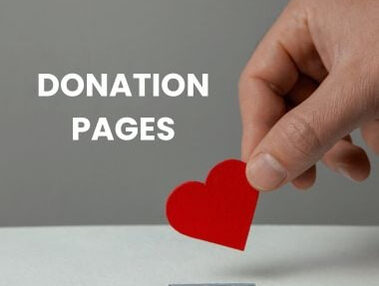How to Write a Fundraising Plan to Boost Donations
Wisdom dictates that you plan before embarking on any task. That’s even more important when you’re asking others to donate their hard-earned dollars.
If you don’t know how to write a fundraising plan, you’re in luck. We’ve put together an explainer on how to get it done. Follow these steps, and you’ll ensure a successful fundraising campaign.
1. Define Your Fundraising Goals and Objectives
Your first order of business when planning fundraising activities should be defining your goals and objectives. Goals give your fundraising efforts direction. Fundraising strategies stem from goal-setting.
In this case, your goal is to increase donations. But you should make that goal SMART.

These types of goals help you stay focused. But what do you mean by a SMART goal? It should have these characteristics:
-
Specific: When the goal is specific, there’s no doubt as to what you’re working towards accomplishing.
-
Measurable: Measurability helps you quantify your results and gauge the progress you’re making.
-
Attainable: Your goal should be realistic.
-
Relevant: Relevance keeps you going when the going gets tough. In other words, it’s your “Why.”
- Time-Bound: Your goal should have a deadline within which you should have accomplished it
So, here’s an example of a SMART goal to boost donations: to increase donations by 12% by the end of the year.
Once you’re clear about your goal, you can draw up a list of SMART objectives that will help you reach it. In this case, to increase donations by 12%, your objective could be to increase the number of new donors from 30 to 50 by the first half of the year.
But you’d also need to specify how you plan to reach this objective. So, a sub-objective in the planning process could be to organize a fundraising event. Or, you could launch an email marketing campaign for potential new donors. If you find it difficult to create SMART goals and objectives, consider using an AI content generator like Writer. Just insert the right prompts and the AI will generate the content in seconds.
2. Identify the Audience
Having determined your fundraising objectives and goals, the next step is to identify your audience. Your audience should be the people you want to reach with your fundraising efforts. So, if you use our sample goal above, your audience should be new donors or prospective fundraising donors. You can identify these potential new donors from funder databases.
Here are good places to start:
- Foundation Directory Online
- The Grantsmanship Center site
- Trade association websites
Once you’ve identified your audience, it’s time to do your audience research. In this case, you’ll perform your prospect research. This is self-explanatory. It involves gathering data on prospective donors. This data includes the potential donor’s background, past giving history, if any, among others.
But why do you need specific data about your target audience?
Whether it’s nonprofit, eCommerce, or SaaS content production, you need to know your target audience so you can tailor your marketing collateral according to their interests and preferences. You can use your research to craft effective fundraising strategies, too.
Once you have all your research, gather all the data and create audience profiles that will inform your fundraising decisions.
One final tip: consider segmenting the audience you identify.
So, in this case, determine the potential gifts of prospective individual donors based on their giving history, for example. Then classify them into major, mid-level, or small-dollar potential donors. Typically, major gift amounts are from $10,000 and above. Mid-level ones can fall between a couple of hundred to a few thousand dollars. Small dollar amounts are classified as anything under $50. Of course, the above classifications vary from organization to organization.
As to why you’d want to segment by gift, segmentation will help you determine the more specific fundraising approach for each potential donor/current donor type you identify. So, in this case, you can throw huge fundraising events for potential major donors. For your potential small-dollar donors, you might want to send emails.
3. Write Nonprofit Fundraising Plan
Now you want to put into writing all these fundraising ideas. So, include in your plan your specific goals and objectives, and your identified fundraising initiatives.
For our example goal and objectives, you could have something like this in your plan:
Goal: Increase donations by 12% by the end of the year
Objective: Increase the number of new donors from 30 to 50 by the first half of the year
Sub-objective 1: Organize a fundraising event for potential major donors on March 2
- Brainstorm ideas for a fundraising event
- Create marketing collateral to promote fundraising events (social media posts, emails)
- Promote marketing collateral on Facebook, Twitter, email, etc.
Sub-objective 2: Launch email marketing campaign for potential small-dollar donors on May 9
- Brainstorm incentive/s for giving away email address
- Brainstorm ideas for emails
- Create marketing emails for the email campaign
- Launch campaign
Your strategic plan should also specify your fundraising budget.
Also, determine the technology you’ll use. For instance, you might decide to use ticketing solutions for your fundraising events, content generators for your marketing collateral, or effective tools to schedule the sending of emails for campaigns.

Your detailed plan should also include timelines to keep you on track. You can create an effective fundraising plan calendar like the one above. In your calendar, you’ll need to rank tasks by priority. For example, you’ll likely pay more attention to cultivating your potentially biggest donors since they give the largest gifts.
Make sure you specify who’s in charge of what task in your calendar as well. This will help you determine who should be held accountable if there are fundraising project delays.
When writing strategic fundraising plans, you should use simple language. If you need to use terms that can be subject to interpretation (for instance, “potential major donor”) define them in your plan. This will help ensure everyone in your development team is on the same page.
BONUS: Implement and Adjust If Needed
At this stage, you just need to follow what you specified in your plan. But that doesn’t mean you should stick to it by hook or by crook. You still want to be flexible. Anything can happen during a fundraising calendar year. Your response needs to be agile.
This is why checking in regularly is important. You want to meet your team members every step of the way to see whether they’re on track to completing their tasks. This way, you can also identify any unexpected issues. When that happens, you can brainstorm possible solutions to address them as quickly as possible.
In Closing
To boost donations, you need a fundraising plan. But your plan should be crafted the right way. You learned how to write a fundraising plan that drives donations from this article. You just need to:
- Define your fundraising goals and objectives
- Identify audience
- Write
Implement your plan but adjust when needed. Follow these tips. With an effective plan, you’ll reach that ultimate goal: that increase in donations.

Author: James Westfield
James Westfield is the Marketing Manager for Writer, an AI writing platform designed for teams. He has over 10 years of experience in the industry. When James isn't in the office, you can find him on the golf course.






